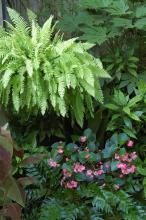Information Possibly Outdated
The information presented on this page was originally released on July 16, 2009. It may not be outdated, but please search our site for more current information. If you plan to quote or reference this information in a publication, please check with the Extension specialist or author before proceeding.
New blonde fern is great in gardens
By Norman Winter
MSU Horticulturist
Central Mississippi Research & Extension Center
Hey, Tiger, there’s a new Blonde in town, and she’s a real looker. I’m neither joking nor talking about girls, but I am referring to two of the hottest ferns in the gardening world.
The Tiger fern has been climbing steadily in popularity, but the competition just got a lot tougher thanks to the Blonde. If you are a fern lover, then you will delight in having both.
The Tiger fern is a Boston-type fern with gold to chartreuse variegation that has a pattern similar to a tiger’s stripes. The colors are so remarkable that the Tiger fern was chosen as the best new foliage plant when it made its debut at the Tropical Plant Industry Expo in Florida.
But it is the Blonde fern that literally flew off the racks at our Mississippi garden and patio shows. The stampede was similar to what you see with shoppers on the Friday after Thanksgiving.
I’ll admit I liked it, but I questioned whether it was worth the fuss gardeners made as they elbowed their way to the display. Last week while filming a Southern Gardening TV segment at the home of Sandra Fowler in Kosciusko, my jaw dropped when I saw the two she had hanging in perfection in her lush, tropical garden.
The Blonde is also a Boston-type fern, and as you might expect from the name, the fronds are bright chartreuse gold. A similar fern in the market is called Rita’s Gold, and it has won awards and accolades from several groups. Some catalogs tout it as compact, while Blonde exhibits a more typical habit. Both are outstanding.
At Sandra Fowler’s home, the ferns were like big lanterns glowing in her shady environment. The first was hanging from a pergola in combination with large, palmate-leaved fatsia; aucuba with spots that echoed the color of the fern; Siam Ruby banana with lime green variegation; holly fern; and hot pink begonias. This combination was stunning.
In another area, she hung it over some hostas with similar leaf color. Instead of a fine-leaf texture like the fern, the hosta was much coarser.
Whether you buy Rita’s Gold or the Blonde fern, remember that areas with shady to high-filtered light give the best performance. Hot afternoon sun will scorch the fronds.
All these ferns require watering, but too much water is more harmful to ferns than too little. Give it a deep soaking, and then let it become slightly dry before the next watering. Feed them with a dilute, water-soluble fertilizer every three to four weeks while they are actively growing. They will not need much fertilizer indoors until you are ready to take them outside in the spring.
There is no doubt these ferns are incredible in hanging baskets, but at our experiment station, we are going to take the next step and place them in the landscape. We will be planting 6-inch containerized plants in woodland landscape beds with gingers, mondo grass and hydrangeas. In another area, we are going to try them as understory plantings to large plantain-type bananas.
If you’ve got shade, then these are must-have ferns. Keep your eyes open and buy them when the opportunity presents itself.








